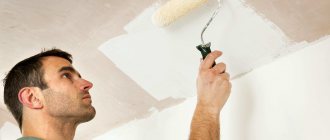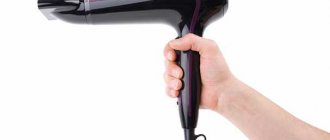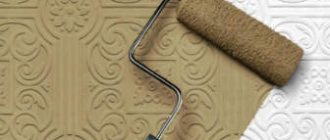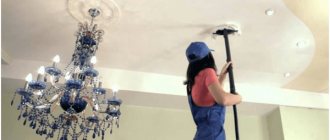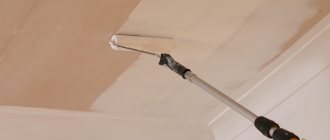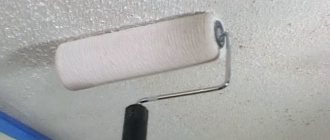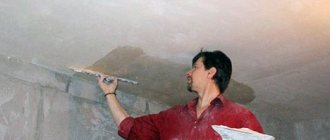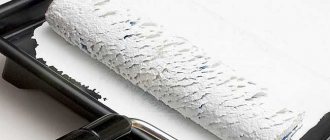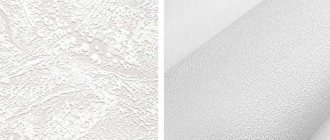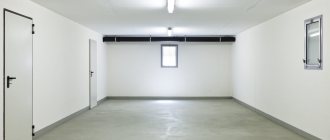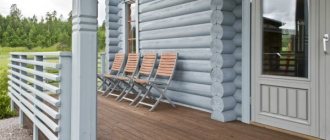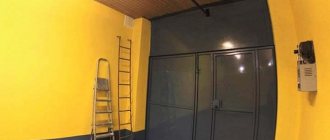Perhaps the most difficult stage of renovation is finishing the ceiling. Moreover, this applies to any type of housing: apartment, house or cottage in rural areas. There are many renovation companies offering a huge selection of finishing options. Unfortunately, not every average resident of the Russian Federation can afford these services. Consequently, the pressing question of finishing the ceiling with your own hands or how to paint the ceiling with water-based paint remains to this day.
Until recently, whitewashing of surfaces was very popular. Whitewashing was carried out using lime dissolved in water. But nowadays new technologies appear every year, or even more often, and people are resorting to this method less and less. This is due to the labor-intensive process of preparatory work, although the ceiling turns out to be snow-white and the price of the work is quite low. In addition, the whitewashed ceiling is very easily soiled.
Nowadays, painting the ceiling with water-based paint is a common type of finishing, because... the ceiling retains its snow-white appearance for quite a long time; in addition, such a coating can be washed, which plays an important role.
Painting the ceiling with water-based paint has a fairly low price. The aqueous emulsion contains various polymers and coloring pigments that are dissolved in water. A positive feature of this coating is that when painted, the polymers that are included in the composition create a moisture-resistant coating. The ceiling painting technology involves intensive evaporation of water after applying the composition to the ceiling surface. In addition, the water emulsion does not create a negative effect on the body, i.e. in all respects it deserves the title of environmentally friendly material.
Selection of aqueous emulsion
In the modern world, there is a huge selection of water emulsions, which include various additives. Therefore, if you decide to paint the ceilings with water-based paint yourself, then you will have to make a choice from a huge assortment. Let's look at what additives can be included in the composition.
- Acrylic additives.
- Acrylic additives with latex.
- Additives based on polyvinyl acetate.
- Silicate additives.
- Additives with mineral composition.
It should be noted that water-based emulsion based on polyvinyl acetate are the cheapest of all listed. The disadvantage of a water emulsion based on this is that such a coating cannot be washed.
The most expensive of these mixtures is a water emulsion with latex. The advantage of such mixtures is the possibility of wet cleaning with detergents.
The most popular mixtures are water-based emulsion with acrylic additives. It is suitable for any room and also has an abrasion-resistant surface. A water-based emulsion with silicate (i.e. liquid glass) is well suited for painting plastered, concrete or stone surfaces.
Also, silicone water emulsion can be applied to the plastered surface, without using a primer. They have high vapor permeability and are well suited for painting a kitchen or bathroom. This type of emulsion protects the surface from the formation of fungus and other parasites.
This begs the question of what type of water-based emulsion to choose so that it creates a good, snow-white coating after painting. Unfortunately, it is very difficult to determine this by the names written on the cans of emulsion. And the seller himself strives to sell the most expensive water-based emulsion, without thinking at all about its quality.
Surface priming
Surface priming is a mandatory stage of preparatory work. Some craftsmen believe that you can skip it and apply a layer of paint directly to the putty or prepared base. But painting the ceiling this way does not give a neat and attractive result.
Application of primer is necessary to improve adhesion between the rough ceiling and the paint composition. The primer also helps strengthen the surface, reduce paint consumption and increase the service life of the coating. In addition, it protects the surface from the appearance of fungus and mold.
The primer composition is chosen in accordance with the paint . So, for acrylic paint you need acrylic primer, and for water-based paint you need a water-based composition. The primer is applied to the putty in 2-3 layers. You can use a roller for these purposes.
Need to read the label
Make it a habit to read the instructions on the label. After all, it contains all the technical characteristics.
- In the annotation you will find what types of work this emulsion is intended for.
- Also there you will find the emulsion consumption per square meter. This is necessary to calculate the required quantity.
- The degree of coverage will also be indicated there - this is the ability or ability of the water emulsion to cover a darker background.
- And finally, the abrasion resistance of the water-based emulsion should be indicated in the annotation.
Pay special attention to the small font in the annotation, because... the manufacturer often enters the main technical characteristics there.
- It is recommended to use the emulsion in dry rooms. Such an inscription notifies the consumer that this paint is not suitable for painting the ceiling in the kitchen. Since in the first case there will be constant oily evaporation, and in the second case there will be increased humidity.
- Leave-in emulsion or highly durable. This means that the ceiling can be washed without the use of cleaning agents and detergents.
- The paint is abrasion resistant. Dirt-repellent property. This surface can be cleaned with detergents.
Tools and materials
Before starting work, you need to purchase tools and materials. In addition to paint, you need primer. Consumption is calculated in accordance with the manufacturer's instructions. You will need masking tape to protect the surfaces. To apply the mixture manually, you need a paint roller and a narrow brush to paint corners and joints.
If we are talking about painting a large surface, then it is recommended to purchase a spray gun (it is equipped with a compressor) or a less powerful spray gun with a paint sprayer.
For stirring you need to select an appropriate container. It is recommended to carry out such work using a construction mixer, but you can use a screwdriver. You should also take care of protective clothing, glasses, and gloves.
Pay attention to: Painting walls in the kitchen: choosing paint, step-by-step instructions and painting options
Types of water emulsion. Where is the best place to buy?
In order to ultimately get the desired effect from coloring, you need to choose the right type. Paint is divided into the following types: glossy, semi-gloss, matte and semi-gloss. The difference between matte paints and glossy paints is the difficulty of washing them. Matte paints have the property of masking small surface defects that would be noticeable on a glossy finish. Therefore, it is better to choose semi-matte or semi-gloss mixtures.
Another important point is that you need to buy water-based paint in a store where the paint is kept warm. If the paint has been frozen at least once, it means that its structure is damaged, and when it thaws it will not be restored. This means that such paint has become unsuitable for use.
Advice! To paint the ceiling, buy special ceiling paint. This paint will not drip, fits perfectly on the surface and has excellent adhesion.
How to properly paint a ceiling with water-based paint
Ceiling preparation
So, answering the question of how to paint with water-based paint, we will first of all talk about the preparatory work. This is the removal of old layers of whitewash or paint. To remove a layer of whitewash, you need to wet the surface of the ceiling with a wet roller and then scrape it off with a spatula. After this procedure, you need to wash the surface with a damp sponge.
How to remove old paint
To update a ceiling that has already been painted with water-based paint, it will take more time, since the preparatory work is a rather labor-intensive process. Its difficulty lies in the difficulty of scraping off the old paint. In addition, it will not be possible to dissolve the old layer of paint with water. Therefore, only the peeling paint is removed during the process.
You can use some trick. It is necessary to wet the surface generously with water. This should be done using a roller. Then you need to let the water soak in thoroughly. And finally, you need to create a draft. Old paint will swell from water, and blisters will form on the ceiling. It will be much easier to scrape off these swellings with a regular spatula. This work must be carried out quickly enough, without allowing the ceiling surface to dry out.
If there are dirty stains from rust or smudges on the ceiling, they can be removed with the following compounds:
- 5% solution of copper sulfate,
- 3% hydrochloric acid solution,
- lime solution with the addition of 50 ml of denatured alcohol.
Leveling the ceiling before painting
This procedure follows the procedure for cleaning the old coating. Thin-layer putty is best suited for it; it has excellent adhesion properties and good ductility. Leveling the ceiling with such putty will give an excellent smooth surface, which can be very easily sanded with fine-grained sandpaper. The putty is applied to the ceiling surface with a spatula.
Sometimes the leveling procedure is carried out using putty-whitewash. It is made on an oil-adhesive basis and is applied to the ceiling surface with a roller or brush. Before treating the ceiling with this putty, you need to seal all the cracks and crevices.
Ceiling primer
The ceiling is primed with the same water-based paint, which is applied in a thin layer. The paint should dry well.
General recommendations
When choosing a method of finishing with water-based emulsion on the ceiling, and during painting work, you must adhere to the following recommendations:
- If the ceiling was plastered in preparation for painting, then it is better to use a spray gun to apply the paint. This way it will be possible to avoid streaks on the ceiling surface;
- If the ceiling is plasterboard, then you need to dilute the paint with water very carefully. Paint liberally diluted with water can soak the drywall layer. As a result, additional repair work will be required;
- When applying the water-based emulsion, it is important to follow the direction of application of the composition indicated in the instructions. If you do not follow this rule, then individual areas will appear on the ceiling that differ in color and structure from the general coating;
- After completion of work, defects may appear on the ceiling. Don't panic and immediately repaint the ceiling. Give the surface time to dry completely. If, after the paint has dried, the defects still remain noticeable, then this layer of coating will have to be removed with sandpaper. Then a new layer of water-based emulsion is applied.
Water emulsion can be used to cover the ceiling in a children's room. The paint composition is absolutely safe and non-toxic.
Water-based emulsion is also used in emergency situations when urgent repairs are necessary. For example, you urgently need to paint the ceiling in a room where the strong smell of the paint composition is unacceptable. The water-based composition will be simply a salvation, because solvents are not needed to thin the paint.
Water emulsions are popular due to the fact that additional expensive materials and tools are not needed during the work process. Another advantage of using emulsion is a fairly simple finishing method. Working with paint does not require any special skills. You can do the painting work yourself using the simplest painting tools. The main thing is to follow the step-by-step process of coloring.
Important: before painting work, the old coating must be removed. The coating will also be removed if the old paint or whitewash does not fly off. Only on the prepared ceiling can a fresh water-based composition be applied.
Technology of painting the ceiling with water-based paint
To understand how to properly paint a ceiling with water-based paint, you need to know what tools you may need for this job.
Tools used for painting
To properly paint the ceiling with water-based paint, you will need the following tools:
- A paint brush will be needed for painting joints and corners
- Narrow paint brush for correction
- Long pile roller with fur coat
- Special paint tray with a ribbed surface
Rules for painting with water-based paint
- The first layer of paint should be applied parallel to the rays of light from the window, the second layer should be applied parallel to the window frame.
- You should always start painting from the joints of the wall and ceiling. This is done with a paint brush, which needs to be moistened with paint, slightly squeezed and a pass made around the perimeter of the ceiling 4-5 cm wide.
- All main work is done with a roller. In total, you need to apply three layers, regardless of the type of paint.
- Allow the paint to dry thoroughly before applying the next coat. This requires from 8 to 12 hours.
Now you know how to paint a ceiling with water-based paint. If you follow all these tips, you will have a beautiful white ceiling.
How to paint wallpaper: subtleties of painting work
If the room has paintable wallpaper, consider a few points:
- After gluing the wallpaper, at least 48 hours must pass so that the wallpaper does not move away from the wall under the influence of the water-based emulsion.
- Use a velor roller.
- First, paint the corners and joints of the walls with a brush, then go over large areas with a roller.
Otherwise, painting wallpaper is no different from applying paint to walls. The main thing is to do everything carefully and not interrupt your work so that there are no streaks or color transitions.
